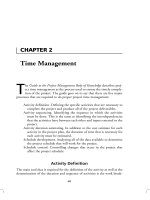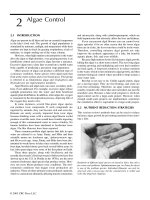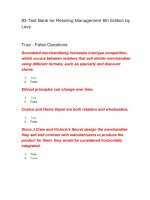Lecture Retailing management (6/e): Chapter 2 - Levy Weitz
Bạn đang xem bản rút gọn của tài liệu. Xem và tải ngay bản đầy đủ của tài liệu tại đây (1.71 MB, 55 trang )
Chapter 2
Types of Retailers
McGrawHill/Irwin
Retailing Management, 6/e
Copyright © 2007 by The McGrawHill Companies, Inc. All rights reserved.
2--
The World of Retailing
Increasing Industry
Concentration
Globalization
Growing Diversity
of Formats
2
2--
General Trends in Retailing
•
•
•
•
•
3
New Types of Retailers
Increased Concentration
Globalization
Growth In Services Retailer
Demise of Pure Electronic Retailers (Webvan,
eToys, etc)
• Growth in Use of Multi-Channel Retailing by
Traditional Retailers
• Increase Use of Technology to Reduce Cost,
Increase Value Delivered
2-4
Merchandise Offering
• Variety (breadth of merchandise)
The number of merchandise categories
Jack Star/PhotoLink/Getty Images
C Squared Studios/Getty Images
Stockbyte/Punchstock Images
• Assortment (depth of merchandise)
The number of items in a category (SKUs)
Royalty-Free/CORBIS
Royalty-Free/CORBIS
Royalty-Free/CORBIS
Royalty-Free/CORBIS
2-5
Variety and Assortment of Bicycles
2--
Types of Retailers
Food Retailers
Mom and Pop Stores
Convenience Stores
Supermarkets
Supercenters
General Merchandise Retailers
Department Stores
Specialty Stores
Discount Stores
Category Specialists
Off-Price Retailers
Warehouse Clubs
6
2--
NAICS Codes for Retailers
7
2--
Food Retailers
Primary Shopping Format for Food Sales
Growth Rates by Retail Format
8
2--
Globalization of Wal-Mart
9
Characteristics of Food Retailers
2-10
Limited Assortment Supermarkets
2-11
Save-A-Lot’s limited assortment format
means that stores carry the most
frequently purchased grocery items in
the most popular size and variety
The company carries high quality
exclusive brands – many produced by
the
same manufacturers of leading name
brands – and an assortment of
nationally
branded items.
Used by permission of Save-A-Lot
This allows Save-A-Lot to offer
savings of up to 40% compared to
conventional grocery stores – without
asking shoppers to sacrifice quality.
2-12
Conventional Supermarket Survival Pack
Emphasize Fresh Perishables
Target health conscious and ethnic consumers
Provide a better in-store experience
Offer more private label brands
Food Retailers
Supermarkets
-Cars, highways and TV to build
brands
-Knowledgeable customers – self
service
-Perishable vs. packaged goods
Big Box Retailers
-Warehouse Clubs
-Supercenters
-Hypermarkets
Convenience Stores
2-13
2-14
Convenience Stores Fight Competition
•
•
•
•
•
•
Tailors associates to local market
Stores are more convenient to shop
Offers fresh food
Fast, casual restaurants
Financial services available
Opening smaller stores closer to
consumers – like airports
Issues in Food Retailing
Competition from Discount Stores
Efficient
Distribution
Lower Costs
Lower Prices
Changing Consumption Patterns
Time Pressure
Eating Out More
Meal Solutions
2-15
2-16
Types of General Merchandise Retailers
•
•
•
•
•
•
•
•
Department Stores
Specialty Stores
Category Specialists
Home Improvement Centers
Discount Stores
Drugstores
Off-Price retailers
Extreme Value Retailers
2-17
Characteristics of General Merchandise
Retailers
2-18
Issues in Department Store Retailing
• Competition
-Discount Stores on Price
-Specialty Stores on Service, Depth of
Assortment
• Lower Cost by Reducing Services (?)
-Centralized Cash Wraps
• More Sales (?)
-Customers Wait for Sale
• Focus on Apparel and Soft Home
• Develop Private Labels and Exclusive Brands
Three Tiers of Department Stores
2-19
First Tier: upscale, high fashion chains with
exclusive designer merchandise and excellent
customer service.
Example: Nordstrom, Neiman Marcus,
Bloomingdales, Saks
Second Tier: Retailers sell more modestly
priced merchandise with less customer service:
Example: Macy’s
Third Tier: Value oriented caters to more price
conscious customer
Example: JCPenney, Sears, Kohl’s
Rob Melnychuk/Getty Images
2-20
What To Do With an Eroding Market
To deal with an eroding market Department stores are:
•attempting to increase the amount of exclusive merchandise
they sell
•undertaking marketing campaigns to develop strong images
for their stores and brands
•building better relationships with
their key customers
Royalty-Free/CORBIS
Issues in Discount Store Retailing
2-21
• Only Big Three Left
Wal-Mart, Kmart, Target
• Wal-Mart’s Dominance
• Differentiate Strategy
Wal-Mart = Low Price and Good value
Target = More Fashionable Apparel
• Competition from Category Specialists
Toys-R-Us, Circuit City, Sports Authority
McGraw-Hill Companies,
Inc./Gary He,
photographer
Issues in Specialty Store Retailing
2-22
Mall-Based Apparel Retailers
Decline in Mall Shopping and
Apparel Sales
-Lack of New Fashions
-Less Interest in Fashion
-Increase Price Consciousness
McGraw-Hill Companies, Inc./Gary He, photographer
Lifestyle Formats – Abercrombie
and Fitch and Hot Topics
Issues in Drug Store Retailing
• Consolidation – Walgreens, CVS,
Rite-Aid
• Competition from Supermarkets,
discount Stores and mail-in orders
• Evolution to a New Format
• -Stand Alone Sites with Drive Thru
Windows
• -offering more frequent purchase
food items
• Improved systems provide
personalized service in the
pharmacy
2-23
Keith Brofsky/Getty Images
Category Specialists
2-24
• Deep and Narrow Assortments
Destination Stores
• Low Price and Service
• Wholesaling to Business
Customers and Retailing to
Consumers
• Incredible Growth
Ryan McVay/Getty Images
Issues in Home Improvement
Centers
Home Depot and Lowes act as both:
Retailer
Wholesaler
Consumer
and
Business
2-25









